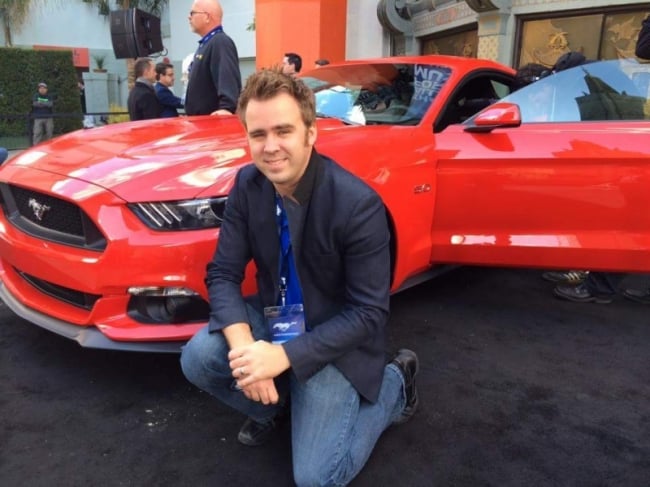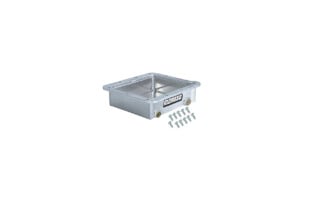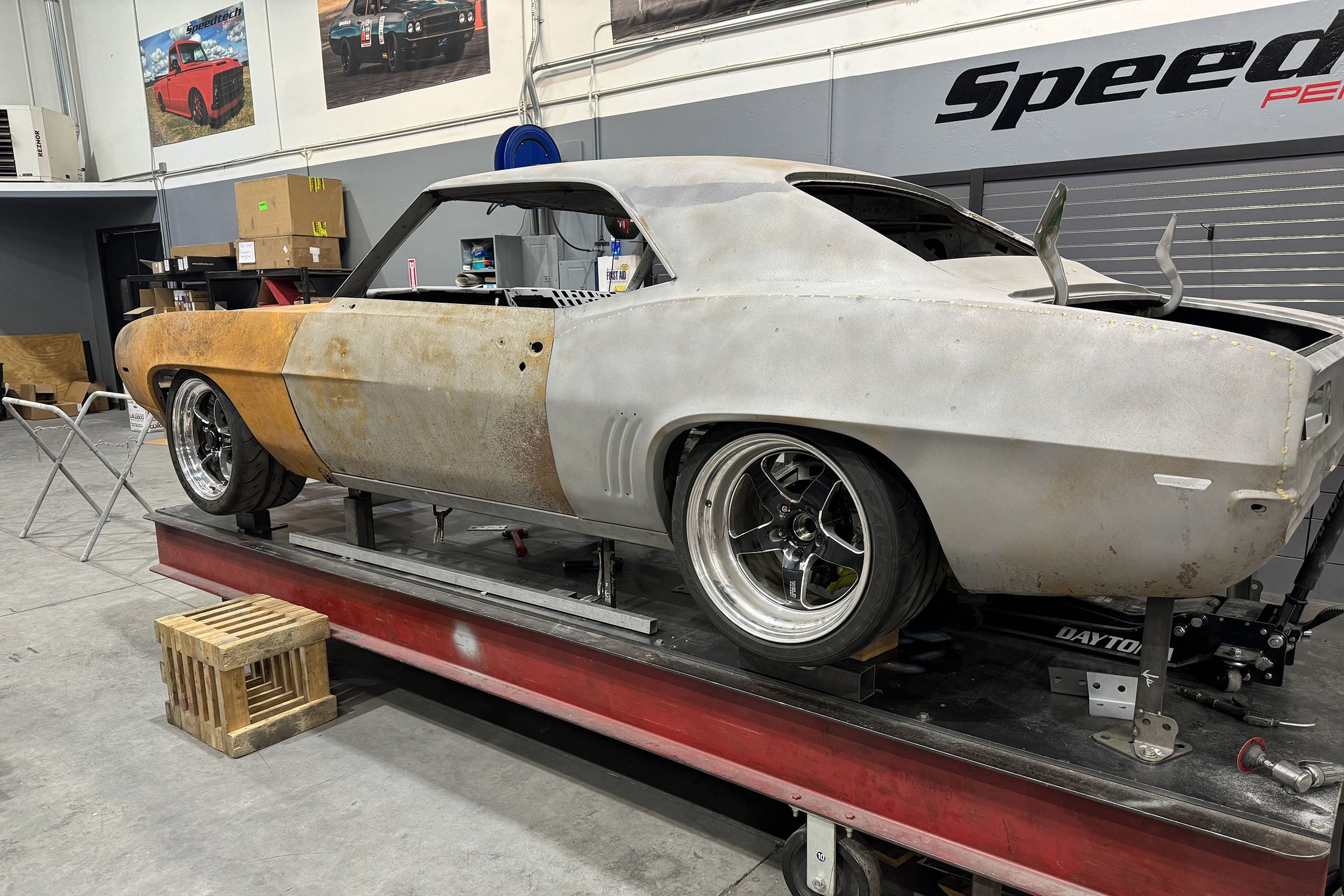When you hear the words “505 horsepower, 0-60 in 3.7 seconds, and 11.7 seconds through the 1320…”, only a few cars come to mind that fit into this super car category. Combine these impressive accolades along with a near 200 mph top speed and a skid pad test of over 1g, and the car options are slimmed down even more. When given the final hint that it costs less than $100,000, then suddenly it all clicks – we must be talking about the Corvette Z06!
Constructed in a fashion similar to full-out race cars, the Z06 is just about the best bang-for-your-buck performance vehicle on the market. For most, the stock power in this street machine is more than most drivers can handle. But what if you desire more? One of the most popular power upgrades for LS engines is an intake manifold and cam swap, and that is exactly what we did by installing an “LSR” valve train upgrade from Comp Cams and an LSX-R intake upgrade by FAST.
The Modded 2008 Z06 & Cunningham Motorsports
The Z06 we were working with on this shoot already had your typical bolt-ons: an air intake, long tube Kooks headers, and a Corsa cat-back exhaust. The acoustics from the exhaust reminded me of a GT2 Corvette skimming through the streets of Long Beach during the yearly ALMS race during the Grand Prix. Other than the HP tuners, this Corvette remained “stock”.

FAST LSX-R Intake Manifold
• Designed for GM L92, LS3 rectangle, and LS7 raised rectangle port heads
• Claimed 16+ hp gains with stock displacement and 26+ rwhp with larger cubic inch
• Removable runners for easy porting

The manifold comes in three different sections. It has the lower and upper shells as well as the trumpets (or runners) inside. “Where we decided during development that the 102mm manifold was going to be the next big step was to make this manifold available to those upgrades that come with the raised rectangle port of the LS7,” Mays stated.
“We wanted to make this manifold a tuner’s tool with being able to modify runner length and the porting ability.” The runners in the manifold are around 12-15% longer than the previous generation manifolds. “We have gone with really short runners to runners that are 3 inches longer than they are now,” Mays continued. “We start with a stock base line then move to a mild cam change. After we had done 300-400 tests, we found the really happy medium for an average application.”

Comp Cams LSR Camshaft – 54-469-11
Duration at .050” Lift: 231 Intake 247 Exhaust
Valve Lift: .617 Intake .624 Exhaust
Lobe Separation: 113
The LSR family of cams extends not only from the rectangle port but also to the cathedral as well. They have done centrifugal blowers, turbos, nitrous, and natural aspiration to come up with a wide range of cam selections. The total number of cam selections under the LSR line is currently sixteen. “We needed a new lobe design (LSL) to run with and the cylinder’s heads have gotten better, therefore we needed to be able to add more lift,” Mays explained. “What we have seen with the LS3 and LS7 platforms is that a lot of those combinations benefited from a little bit longer exhaust lobe.”
Beehive Valve Springs – 26926 — Tool Steel Retainers – 1779-16
Seat Load – 129 @ 1.835
Open Load – 470 @ 1.160
These are the new dual valve springs from Comp Cams. “The 26926 is on a platform by itself,” Mays says. “People wonder what can change in regards to a valve spring over the years, and a lot can change as the metals get better.”
According to Comp Cams, the new tool steel retainers would be a notch up over the titanium retainers. The weight is almost identical, but the longevity is much greater with the tool steel.

Springs, Keepers, and Retainers
The first and easiest part of the the valve train installation is the valve springs and retainers. With the coil packs removed and the valve covers off, Mike went to work on removing the springs. Ryne and Mike designed a homemade removal tool that is a cut up rocker that they can bolt on the stock rocker location to compress the spring. To keep the valve from falling down into the cylinder, a spark plug was removed and an air line was attached.

Removing the cam out of a Corvette is not the easiest install by any means. The design of the rack on the C6 puts it in front of the crank pulley. Also, parts like the front air intake ducting and radiator must be removed to allow proper room for the cam to come out. There are a few different ways to swap the cam, but the way they do it at Cunningham Motorsports is by dropping down the front K-member.



Carefully remove the three bolts that hold the timing gear onto the cam. With a long bolt, carefully turn and pull the cam out. Before sliding in the LSR cam, Mike lubed up the new cam with Comp’s installation lubricant. We installed the cam back in place and then installed the gear making sure we were still dot-to-dot on the timing. Then we reversed the procedure and got the motor all back together.
It’s “FIRE IN THE HOLE” Time
When we cranked the key, our thoughts were on the FAST intake and LSR cam. How different would it sound? Well, we found out.
Our Z06 sounded like a totally different car. “It is definitely not the most tame camshaft in the LSR line,” Mays stated. “I would put it in a 3-4 out of 10 range for how aggressive the cam is. The good thing about this cam, though, is it is a good daily driver cam.” The ‘Vette now has a healthy grumble, thanks to our moderately aggressive LSR cam.
After giving it some idling and revving time, Ryne put the Z06 back onto the dyno for some numbers in order to make sure everything was correct.
After some tuning and getting the vehicle back to the same temperature as it was in the “before” dynos, we netted an impressive gain of 45 horsepower and 23 ft/lb of torque to the rear tires, totaling 540 horsepower and 485 lb/ft. The cam impressively did exactly what it was deigned to do and increased power all the way through the RPM band. Now that we had our numbers from the cam install, Ryne moved the Z06 back into the shop so Mike could swap out the stock LS7 intake manifold for the FAST 102mm.

An intake manifold swap on a Corvette is significantly easier than on a F-body. Mike started by once again removing the stock intake and its associated wiring. He then took off the 4 bolts that hold the throttle body on and all of the affiliated plumbing to the throttle body. From there, Mike removed the fuel lines (best done with the gas cap off to release the fuel pressure in the tank) and cross-over tubes. He unplugged all the injectors and unbolted the fuel rail, taking the injectors with him.

FAST Fuel Rail Kit
To guarantee that we were going to get all the fuel supply we needed to this LS7 throughout its life, we installed a FAST fuel rail kit. With the newly installed intake manifold, the LS7 fuel rails will not fit. Instead, it requires either the FAST rails or LS3 OEM rails. While the stock LS7 rails do fit the factory injectors perfectly, custom fuel lines are required for the cross-over and the T back to the OEM fuel line.

Thanks to the OEM-like fitment of the FAST intake and easy to reach design of the Corvette chassis, the intake installation was completed in under two hours. Ryne and the crew from Cunningham Motorsports strapped the C6 back onto the dyno for its final runs with the new intake installed.
The power gains were very strong in the mid range, as much as 15-18 hp and 16-20 lb of torque at some points, with 8 horsepower and 17 lb/ft of torque additional at the peak. This now brought our new total power increase to 52 horsepower and 31 ft/lb of torque at the rear wheels.
One of the great aspects of the FAST intake is that it will continue to produce even more power as modifications increase, especially in forced induction applications. In a little over a day we were able to install a moderately sized camshaft and supporting valve train to help our Z06 breathe a little easier. With the addition of the new FAST 106mm intake manifold, those numbers were increased further. Great power gains for a 100% street-able Corvette!





















